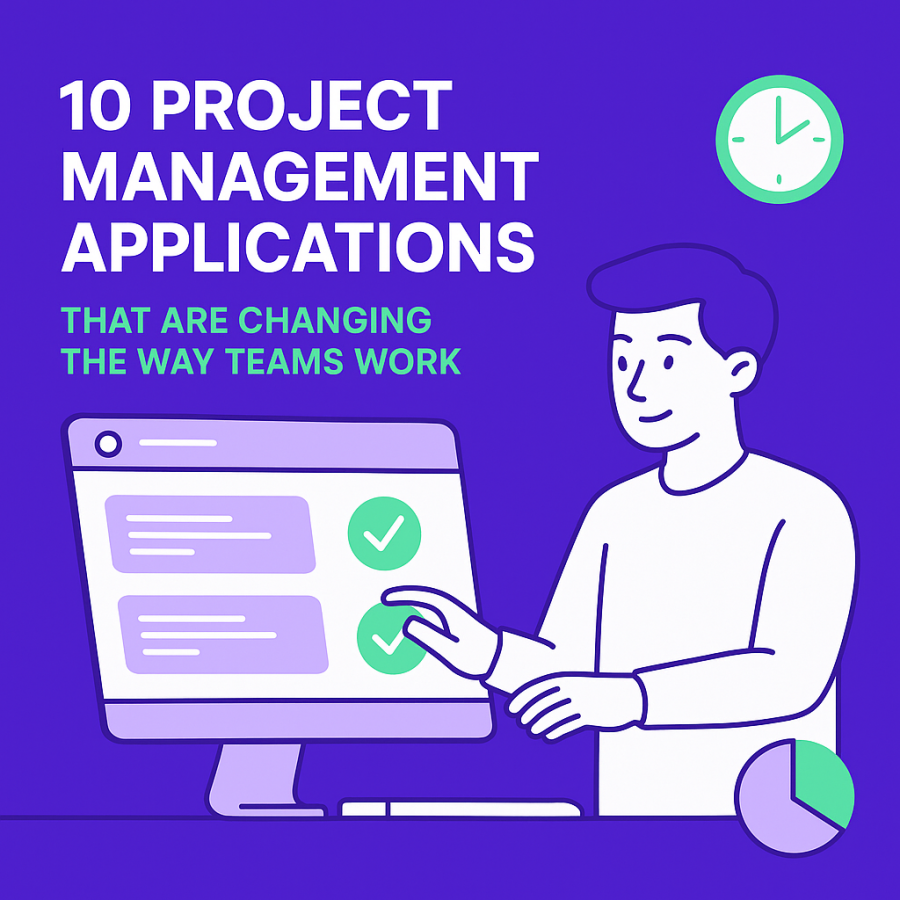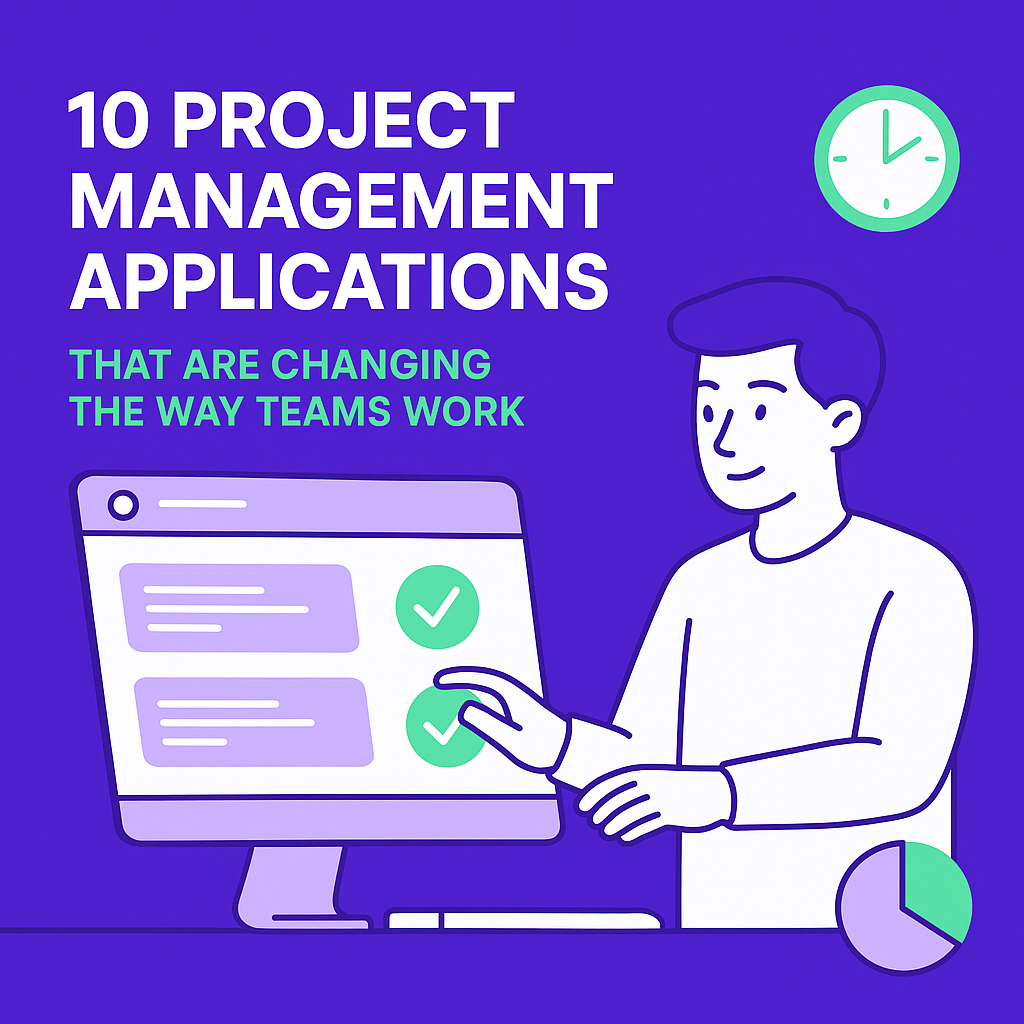Abstract
Project management (PM) has evolved significantly over the last two decades, driven by technological advances and shifting workplace paradigms. Modern project management software integrates collaboration, automation, and analytics, fundamentally transforming how teams operate. This article explores ten leading project management applications, detailing their features, strengths, and impact on team productivity and workflows. Through a critical review, the article examines how these tools facilitate agile practices, remote work, and data-driven decision-making, highlighting their role in reshaping team dynamics in various industries.
Introduction
The complexity of projects in contemporary organizations necessitates effective coordination among diverse stakeholders, clear communication, and real-time visibility into progress. Project management software has emerged as an essential solution to address these challenges, offering tools that extend beyond simple task tracking to comprehensive work orchestration platforms.
With the rise of remote and hybrid working models, increased project complexity, and demand for agile methodologies, project management tools have had to evolve rapidly. They now often include features such as automation, integrations with other business systems, natural language processing, and advanced analytics to provide actionable insights.
This article reviews ten prominent project management applications that are at the forefront of this transformation. The selection represents a mix of established platforms and emerging solutions, each with unique strengths that cater to different organizational needs.
- Asana: The Flexible Work Manager
Asana, founded in 2008 by Facebook co-founder Dustin Moskovitz and software engineer Justin Rosenstein, is recognized for its flexible project and task management capabilities. Designed to streamline workflows for teams of all sizes, Asana combines simplicity with power.
Features and Strengths
Asana offers multiple project views, including lists, boards, calendars, and timelines (Gantt charts), which allow teams to visualize their work in the most intuitive format. One of its key strengths is customizable automation workflows that reduce repetitive tasks, such as auto-assigning tasks or setting due date reminders.
The platform integrates with over 200 applications, including Slack, Microsoft Teams, Google Drive, and Zoom, enabling teams to centralize communication and documentation.
Impact on Teams
Asana has been shown to improve cross-functional collaboration by providing a shared workspace with transparent task ownership and deadlines. A 2022 survey by Forrester Consulting found that organizations using Asana reported a 45% increase in team productivity and a 40% reduction in project delays.
Limitations
While powerful, Asana's flexibility can be overwhelming to new users, especially those without formal project management experience. Its reliance on integrations also means that organizations must manage multiple tools, potentially leading to fragmented workflows.
2. Trello: Visual Task Management for Agile Teams
Trello, acquired by Atlassian in 2017, popularized the Kanban board style for project management, which represents tasks as cards moved across columns denoting stages of progress.
Features and Strengths
Trello’s interface is intuitive and visually engaging, making it easy for users to track progress at a glance. The addition of “Power-Ups” extends functionality, including calendar views, automation (Butler), and integrations with platforms like Jira, Google Drive, and Slack.
It’s particularly favored by startups and small teams for its simplicity and quick setup. Trello also supports collaborative features such as comments, attachments, and due dates.
Impact on Teams
By emphasizing visual workflow management, Trello helps teams maintain clarity and adapt quickly to changes. Studies show Kanban-based tools increase focus and reduce multitasking inefficiencies. Trello has been instrumental in the adoption of Agile practices beyond software development, including marketing and HR teams.
Limitations
Trello can become cumbersome for complex projects requiring detailed task dependencies and resource management. Its power-ups, while useful, can incur additional costs and complicate the user experience.
3. Jira: The Developer’s PM Powerhouse
Jira is arguably the most dominant project management tool within software development environments, especially where Agile, Scrum, or Kanban methodologies are applied.
Features and Strengths
Developed by Atlassian and launched in 2002, Jira offers extensive issue and bug tracking, sprint planning, and release management tools. It supports highly customizable workflows and advanced reporting features like burndown charts and velocity tracking.
Jira integrates tightly with developer tools such as Bitbucket, Confluence, and various CI/CD pipelines, providing end-to-end visibility in software delivery.
Impact on Teams
Jira’s robust feature set supports software teams in iterative development, helping reduce cycle times and improve release quality. According to a 2023 report by Gartner, Jira leads the market with over 70% adoption among Agile software teams globally.
Limitations
Jira’s complexity requires significant training and setup. Smaller teams may find it overkill, and its interface has been criticized for being less user-friendly compared to newer PM platforms.
4. Monday.com: A Work Operating System for Everyone
Monday.com brands itself as a “Work OS,” a platform designed not just for project management but for organizing all types of work, from sales pipelines to HR onboarding.
Features and Strengths
Its drag-and-drop interface allows users to create custom workflows and dashboards with ease. Monday.com provides automation for repetitive tasks and integrates with popular tools like Salesforce, Zoom, Excel, and Microsoft Teams.
A key differentiator is its adaptability across industries, offering templates suited for marketing, construction, education, and IT.
Impact on Teams
Monday.com’s versatility makes it a central hub for diverse teams, fostering collaboration across departments. A 2024 case study by IDC showed a 50% reduction in project turnaround times and improved cross-team communication in companies using Monday.com.
Limitations
Pricing can be a barrier for small businesses or freelancers, as many advanced features require premium plans. Some users report that customization can become complex as workflows grow.
5. Microsoft Project: The Enterprise Standard
Microsoft Project has been a staple in enterprise project management since the 1980s, evolving into a comprehensive tool for scheduling, resource management, and portfolio oversight.
Features and Strengths
Microsoft Project provides advanced Gantt chart functionality, critical path analysis, and detailed resource leveling capabilities. Integration with Microsoft 365 and Power BI allows sophisticated reporting and collaboration.
It supports both waterfall and hybrid project methodologies and scales well in large organizations managing multiple projects simultaneously.
Impact on Teams
Its widespread adoption in corporate environments stems from deep Microsoft ecosystem integration, enabling alignment between project management, finance, and operations. Studies show Microsoft Project helps reduce resource conflicts and improve project forecasting accuracy.
Limitations
The software is complex and has a steep learning curve. Licensing costs and the need for dedicated project managers can limit accessibility for smaller teams.
6. ClickUp: The All-in-One Work Platform
ClickUp is an emerging competitor that markets itself as a platform consolidating project management, docs, goal tracking, and chat.
Features and Strengths
ClickUp supports multiple views including list, board, calendar, and Gantt charts, allowing teams to work in their preferred style. It offers powerful automation, time tracking, and goal setting features.
With over 1,000 integrations and an open API, ClickUp can fit into varied tech stacks. Its pricing model is attractive for small and medium businesses.
Impact on Teams
By combining multiple productivity tools in one platform, ClickUp reduces tool fragmentation and streamlines workflows. User testimonials emphasize improvements in transparency and accountability across teams.
Limitations
The abundance of features can overwhelm new users, and performance issues have been reported with very large projects.
7. Smartsheet: Spreadsheet Meets Collaboration
Smartsheet builds on the familiarity of spreadsheets, offering a collaborative platform enhanced with workflow automation and project visualization tools.
Features and Strengths
It supports grid, card, Gantt, and calendar views, making it easy for teams accustomed to Excel to transition. Automated alerts, approval workflows, and real-time reporting make it suitable for complex project environments.
Smartsheet’s enterprise features include compliance management and integrations with Salesforce, Jira, and Google Workspace.
Impact on Teams
Organizations using Smartsheet report improved project visibility and better resource management. Its spreadsheet interface allows non-technical users to adopt PM practices quickly.
Limitations
Smartsheet may lack the depth of Agile-specific tools and can become costly as user count grows.
8. Wrike: Enterprise-Focused Agile Collaboration
Wrike is designed for teams needing robust project tracking, real-time collaboration, and in-depth analytics, particularly in marketing, creative, and professional services.
Features and Strengths
Wrike provides customizable workflows, task dependencies, time tracking, and proofing tools. Its analytics dashboard offers insight into project health, resource utilization, and risk areas.
Integration with Salesforce, Adobe Creative Cloud, and Microsoft Teams helps teams maintain synchronized workflows.
Impact on Teams
Wrike’s analytics-driven approach supports better decision-making and risk mitigation, helping teams deliver projects on time and within budget.
Limitations
Wrike’s interface and pricing model can be complicated, requiring a dedicated administrator to manage configurations.
9. Basecamp: Simplicity and Communication
Basecamp focuses on delivering straightforward project collaboration without overwhelming features. It combines messaging, file sharing, task lists, and scheduling in a single platform.
Features and Strengths
Its minimalist design reduces friction for teams new to project management software. Features such as automatic check-ins and simple to-do lists help maintain team alignment.
Basecamp is popular among creative agencies and small businesses that prioritize communication over complex task dependencies.
Impact on Teams
By emphasizing communication, Basecamp reduces email overload and fosters a transparent working environment. Teams often report increased clarity in responsibilities and deadlines.
Limitations
Basecamp lacks advanced project planning features such as Gantt charts, resource management, and automation, limiting its suitability for large or complex projects.
10. Artavolo: Leveraging Natural Language for Task Management
Artavolo represents a new wave of project management applications integrating natural language processing (NLP) to simplify project creation and management.
Features and Strengths
Users can create, assign, and update tasks using conversational commands, reducing the friction of traditional data entry. Artavolo offers automated reminders, secure cloud storage, and real-time collaboration features.
Its security-first architecture ensures sensitive project data is protected through encryption and compliance with industry standards.
Impact on Teams
Artavolo accelerates project setup and task management, especially for teams adopting agile or lean methodologies. Early adopters report improved user engagement and faster onboarding of new team members.
Limitations
As a newer platform, Artavolo is still expanding integrations and scaling features to meet enterprise needs.
Comparative Analysis and Discussion
Across these ten platforms, several themes emerge:
-
User Experience vs. Complexity: Simpler tools like Trello and Basecamp prioritize ease of use, appealing to small teams and non-technical users. In contrast, Jira and Microsoft Project offer deep functionality suitable for large enterprises but require training and dedicated management.
-
Agility and Flexibility: Many tools support Agile methodologies, but their approaches differ. Jira is tailored for software teams, whereas platforms like Monday.com and ClickUp provide more generalized agility.
-
Integration Ecosystems: The ability to connect with other tools is crucial. Platforms with extensive integration networks allow teams to build cohesive workflows.
-
Automation and AI: Increasingly, project management software incorporates automation to reduce manual effort. Emerging NLP capabilities, such as those in Artavolo, represent the future direction.
-
Security and Compliance: Especially for enterprise and regulated industries, data protection is paramount. Platforms vary in their approaches to security, compliance, and data sovereignty.

